Dual-Wavelength Mode-Locked Oscillation with Graphene Nanoplatelet Saturable Absorber in Erbium-Doped Fiber Laser
Abstract
:1. Introduction
2. Characterization of Graphene Nanoplatelets Saturable Absorber
3. Experimental Setup
4. Results and Discussion
5. Conclusions
Author Contributions
Funding
Acknowledgments
Conflicts of Interest
References
- Tang, Y.; Li, F.; Yu, X. Dual-wavelength harmonic mode-locked dissipative soliton resonance of Yb fiber laser. Opt. Laser Technol. 2022, 152, 108147. [Google Scholar] [CrossRef]
- Liu, T.; Yan, M.; Guo, Z.; Zeng, H. Mechanisms of Dual-Wavelength Mode-Locking in Fiber Lasers. 2022. Available online: http://dx.doi.org/10.2139/ssrn.4008868 (accessed on 20 July 2022).
- Long, J.; Gao, Y.; Lin, W.; Wu, J.; Lin, X.; Hong, W.; Cui, H.; Luo, Z.; Xu, W.; Luo, A.-P. Switchable and spacing tunable dual-wavelength spatiotemporal mode-locked fiber laser. Opt. Lett. 2021, 46, 588–591. [Google Scholar] [CrossRef] [PubMed]
- Wang, Z.; Liu, C.; Su, X.; Wang, Y.; Xie, Y.; Gao, F.; Kumar, S.; Zhang, B. Dual-wavelength mode-locked laser based on optimization of erbium-doped fiber length. Optik 2021, 251, 168370. [Google Scholar] [CrossRef]
- Armas-Rivera, I.; Rodriguez-Morales, L.A.; Durán-Sánchez, M.; Ibarra-Escamilla, B. Dual-wavelength mode-locked Er-doped fiber laser in a spectral filter free cavity. Opt. Laser Technol. 2021, 142, 107222. [Google Scholar] [CrossRef]
- Luo, X.; Tuan, T.; Saini, T.; Nguyen, H.; Suzuki, T.; Ohishi, Y. Switchable dual-wavelength mode-locked fiber laser using Saganc loop mirror. Opt. Commun. 2020, 463, 125457. [Google Scholar] [CrossRef]
- Li, S.; Yin, Y.; Ran, G.; Ouyang, Q.; Chen, Y.; Tokurakawa, M.; Sulaiman, E.L.; Harun, W.; Wang, P. Dual-wavelength mode-locked erbium-doped fiber laser based on tin disulfide thin film as saturable absorber. J. Appl. Phys. 2019, 125, 243104. [Google Scholar] [CrossRef]
- Lau, K.Y.; Zulkifli, M.Z. 1.56 µm and 1.93 µm synchronized mode-locked fiber laser with graphene saturable absorber. Infrared Phys. Technol. 2021, 112, 103606. [Google Scholar] [CrossRef]
- Lau, K.Y.; Abu Bakar, M.H.; Muhammad, F.D.; Latif, A.A.; Omar, M.F.; Yusoff, Z.; Mahdi, M.A. Dual-wavelength, mode-locked erbium-doped fiber laser employing a graphene/polymethyl-methacrylate saturable absorber. Opt. Express 2018, 14, 12790–12800. [Google Scholar] [CrossRef]
- Kobtsev, S.M. Artificial saturable absorbers for ultrafast fibre lasers. Opt. Fiber Technol. 2022, 68, 102764. [Google Scholar]
- Xu, D.; Zhang, H.; Peng, J.; Chen, J.; Yang, X.; Li, D.; Li, Z.; Zheng, Y. Passively mode-locked ytterbium-doped fiber laser based on Fe3O4 nanosheets saturable absorber. Photonics 2022, 9, 306. [Google Scholar] [CrossRef]
- Dong, L.; Chu, H.; Li, Y.; Zhao, S.; Li, D. Third-order nonlinear optical responses of CuO nanosheets for ultrafast pulse generation. J. Mater. 2022, 8, 2–511. [Google Scholar] [CrossRef]
- Hou, R.; Li, H.; Diao, M.; Sun, Y.; Liang, Z.; Yu, Z.; Huang, Z.; Zhang, C. Fast electrochemical activation of the broadband saturable absorption of tungsten oxide nanoporous film. Nano Res. 2022, 15, 326–332. [Google Scholar] [CrossRef]
- Ahmad, H.; Hidayah, N.; Yusoff, N.; Zharif, M.; Aisyah, S.; Faizal, M.; Bayang, L.; Wang, Y.; Wang, S.; Sahu, J. Passively Q-switched 1.3 μm bismuth doped-fiber laser based on transition metal dichalcogenides saturable absorbers. Opt. Fiber Technol. 2022, 69, 102851. [Google Scholar] [CrossRef]
- He, J.; Lu, H.; Tao, L.; Zhao, Y.; Zheng, Z.; Zhou, B. Novel two-dimensional semi-metallic NiTe2 based saturable absorber for ultrafast mode-locked fiber laser. Infrared Phys. Technol. 2022, 123, 104195. [Google Scholar] [CrossRef]
- Haris, H.; Batumalay, M.; Tan, S.J.; Markom, A.M.; Muhammad, A.R.; Harun, S.W.; Megat Hasnan, M.M.I.; Saad, I. Mode-Locked YDFL Using Topological Insulator Bismuth Selenide Nanosheets as the Saturable Absorber. Crystals 2022, 12, 489. [Google Scholar] [CrossRef]
- Zhang, X.; Xing, X.; Li, J.; Peng, X.; Qiao, L.; Liu, Y.; Xiong, X.; Han, J.; Liu, W.; Xiao, W.; et al. Controllable epitaxy of quasi-one-dimensional topological insulator α-Bi4Br4 for the application of saturable absorber. Appl. Phys. Lett. 2022, 120, 093103. [Google Scholar] [CrossRef]
- Ai, F.; Li, X.; Qian, J. Dual-wavelength mode-locked fiber laser based on graphene materials. Eur. Phys. J. Spec. Top. 2022, 231, 643–649. [Google Scholar] [CrossRef]
- Hua, K.; Wang, D.N.; Chen, Q. Passively mode-locked fiber laser based on graphene covered single-mode fiber with inner short waveguides. Opt. Commun. 2022, 505, 127520. [Google Scholar] [CrossRef]
- Li, X.; Wang, D.N.; Hua, K.; Chen, Q.; Ge, Y.; Xia, Q.K. Saturable absorber based on graphene for a hybrid passive mode-locked erbium-doped fiber laser. Opt. Fiber Technol. 2022, 70, 102867. [Google Scholar] [CrossRef]
- Abas, A.F.; Lau, K.Y.; Abdulkawi, W.M.; Alresheedi, M.T.; Muhammad, F.D.; Mahdi, M.A. Dispersion management and pulse characterization of graphene-based soliton mode-locked fiber lasers. Appl. Sci. 2022, 12, 3288. [Google Scholar] [CrossRef]
- Yap, Y.; Chong, W.; Razgaleh, S.A.; Huang, N.; Ong, C.; Ahmad, H. Performance of Q-switched fiber laser using optically deposited reduced graphene oxide as saturable absorber. Fiber Integr. Opt. 2022, 41, 26–40. [Google Scholar] [CrossRef]
- Ponarina, M.; Okhrimchuk, A.; Alagashev, G.; Orlova, G.; Dolmatov, T.; Rybin, M.; Obraztsova, E.; Bukin, V.; Obraztsov, P. Wavelength-switchable 9.5 GHz graphene mode-locked waveguide laser. Appl. Phys. Express 2021, 14, 072001. [Google Scholar] [CrossRef]
- Hua, K.; Wang, D.N. Coupling scheme for graphene saturable absorber in a linear cavity mode-locked fiber laser. Opt. Lett. 2021, 46, 17–4362. [Google Scholar] [CrossRef] [PubMed]
- Peng, X.; Yan, Y. Graphene saturable absorbers applications in fiber lasers. J. Eur. Opt. Soc. Rapid Publ. 2021, 17, 16. [Google Scholar]
- Wang, F.; Drzal, L.T.; Qin, Y.; Huang, Z. Mechanical properties and thermal conductivity of graphene nanoplatelet/epoxy composites. J. Mater. Sci. 2015, 50, 1082–1093. [Google Scholar] [CrossRef]
- Lau, K.Y.; Zainol Abidin, N.H.; Abu Bakar, M.H.; Latif, A.A.; Muhammad, F.D.; Huang, N.M.; Omar, M.F.; Mahdi, M.A. Passively mode-locked ultrashort pulse fiber laser incorporating multi-layered graphene nanoplatelets saturable absorber. J. Phys. Commun. 2018, 2, 075005. [Google Scholar] [CrossRef]
- Latif, A.A.; Mohamad, H.; Abu Bakar, M.H.; Muhammad, F.D.; Mahdi, M.A. Carbon nanotube-based mode-locked wavelength-switchable fiber laser via net gain cross section alteration. Laser Phys. 2016, 26, 025106. [Google Scholar] [CrossRef]
- Yang, H.R. Switchable dual-wavelength fiber laser mode-locked by monolayer graphene on D-shaped fiber. J. Mod. Opt. 2015, 62, 1363–1367. [Google Scholar] [CrossRef]
- Sotor, J.; Sobon, G.; Tarka, J.; Pasternak, I.; Krajewska, A.; Strupinski, W.; Abramski, K. Passive synchronization of erbium and thulium doped fiber mode-locked lasers enhanced by common graphene saturable absorber. Opt. Express 2014, 22, 5536–5543. [Google Scholar] [CrossRef]
- Hamra, A.A.B.; Lim, H.N.; Chee, W.K.; Huang, N.M. Electro-exfoliating graphene from graphite for direct fabrication of supercapacitor. Appl. Surf. Sci. 2016, 360, 213–223. [Google Scholar] [CrossRef]
- Ferrari, A.C.; Meyer, J.C.; Scardaci, V.; Casiraghi, C.; Lazzeri, M.; Mauri, F.; Piscanec, S.; Jiang, D.; Novoselov, K.S.; Geim, A.K. Raman spectrum of graphene and graphene layers. Phys. Rev. Lett. 2006, 98, 187401. [Google Scholar] [CrossRef] [PubMed]
- Graf, D.; Molitor, F.; Ensslin, K.; Stampfer, C.; Jungen, A.; Hierold, C.; Wirtz, L. Spatially resolved Raman spectroscopy of single-and few-layer graphene. Nano Lett. 2007, 7, 238–242. [Google Scholar] [CrossRef] [PubMed] [Green Version]
- Garmire, E. Resonant optical nonlinearities in semiconductors. IEEE J. Sel. Quantum Electron. 2000, 6, 1094–1110. [Google Scholar] [CrossRef]
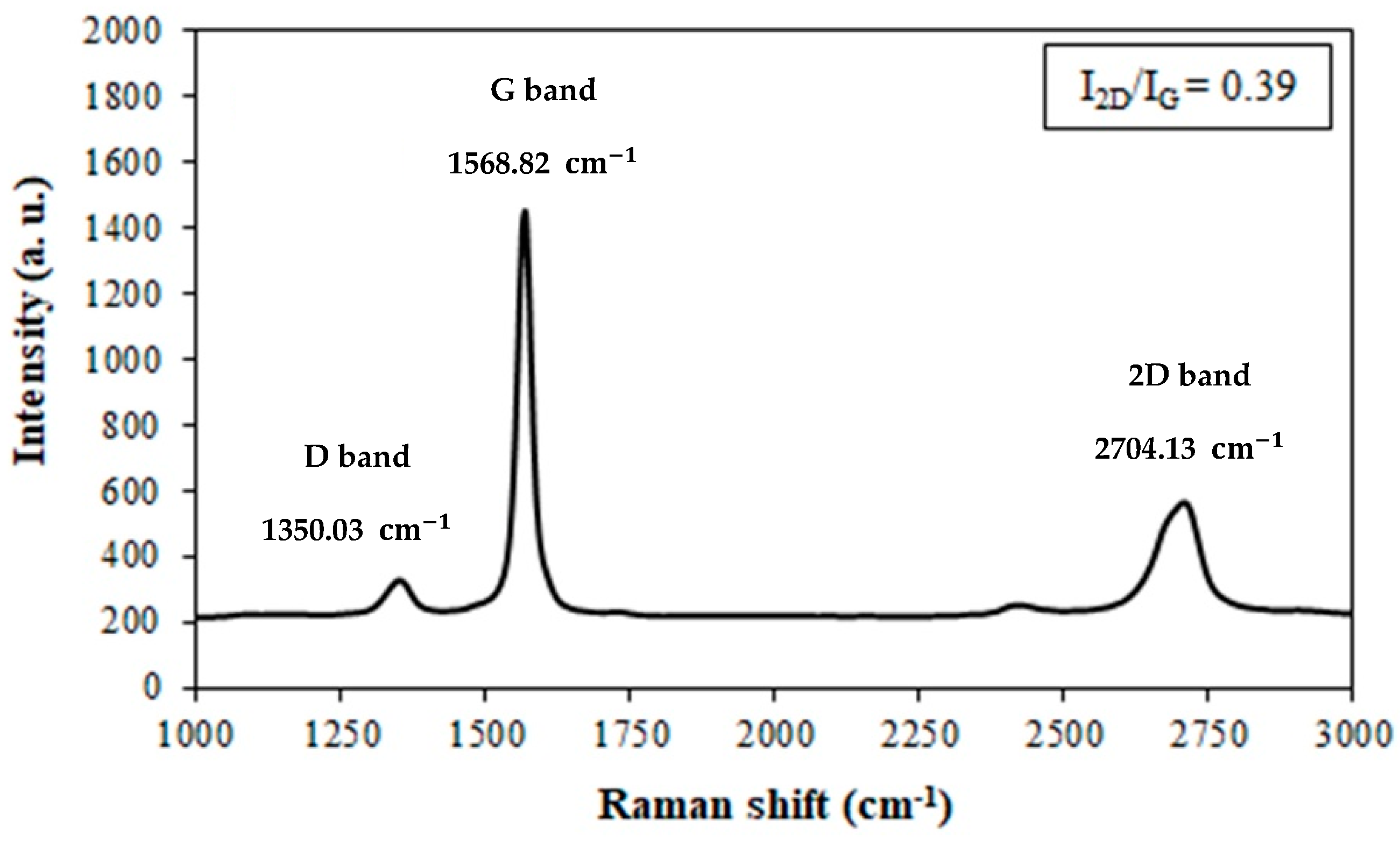
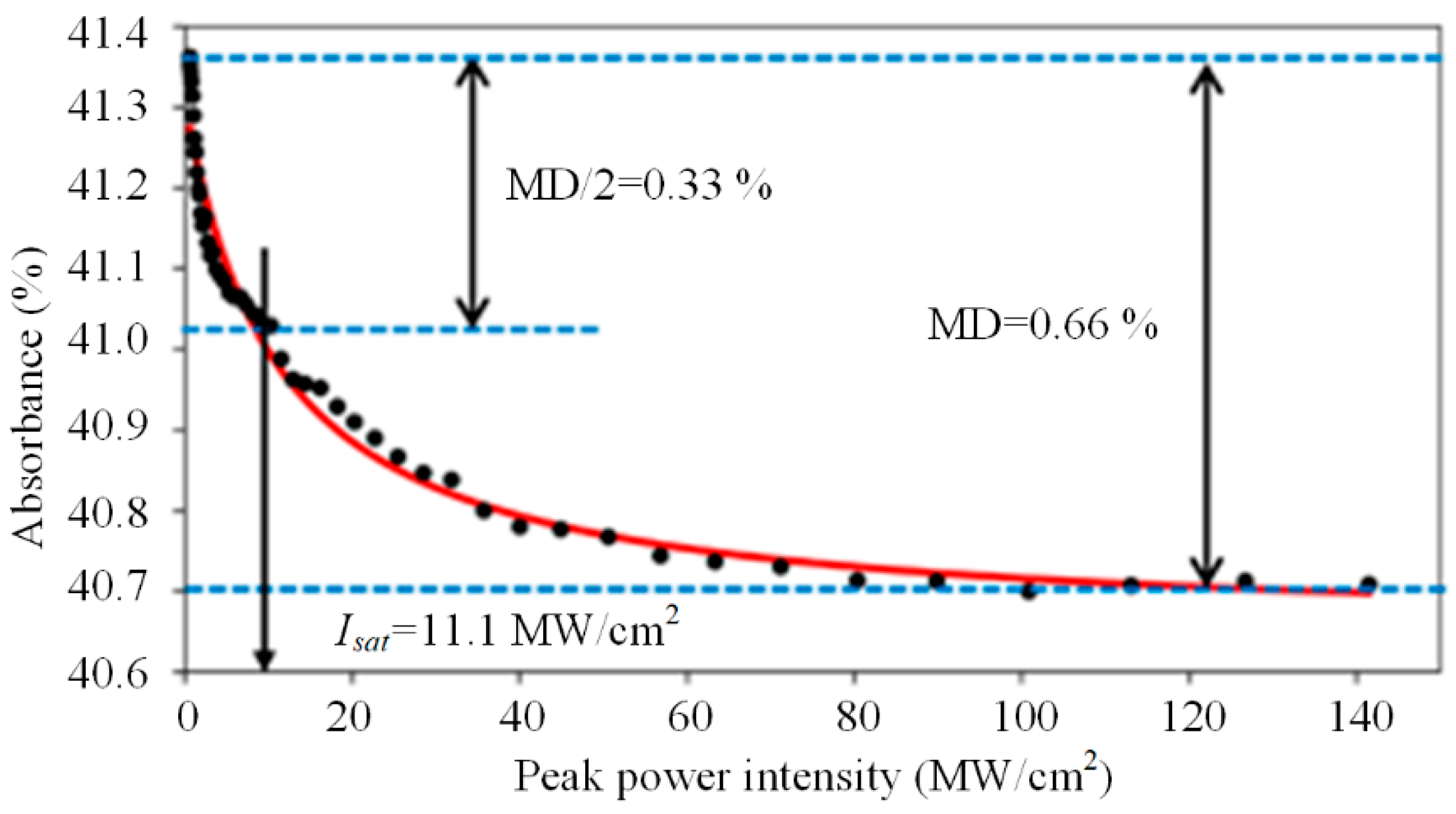
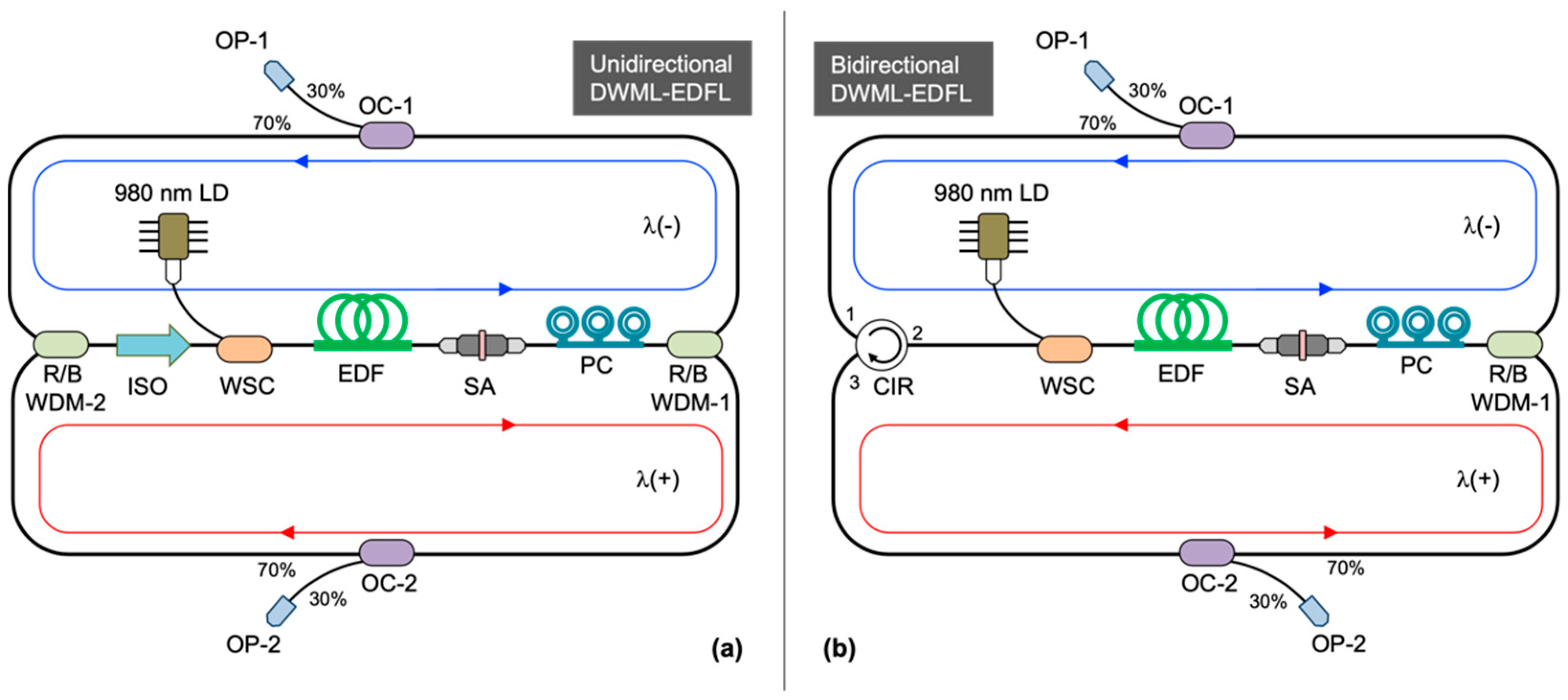
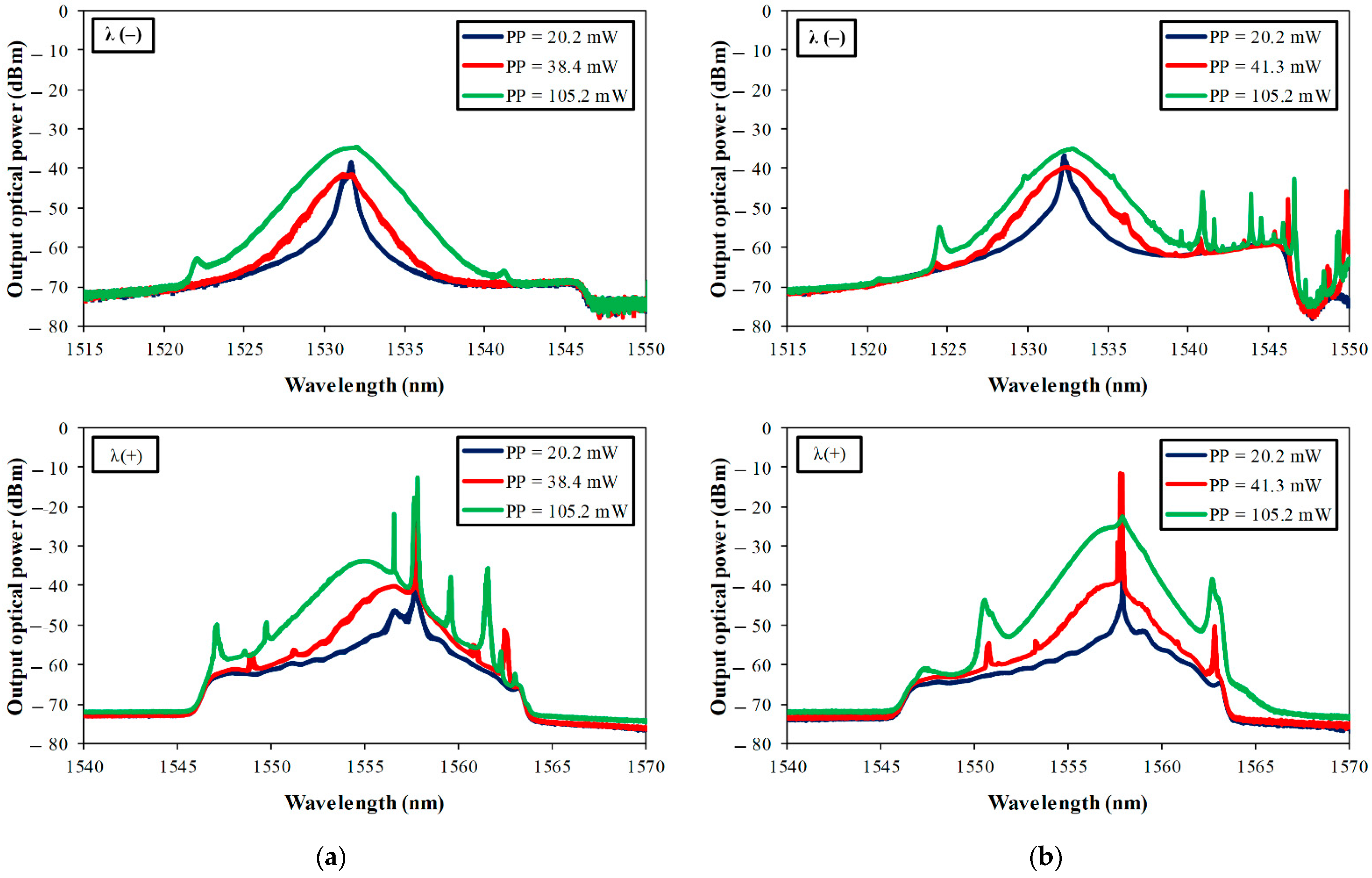


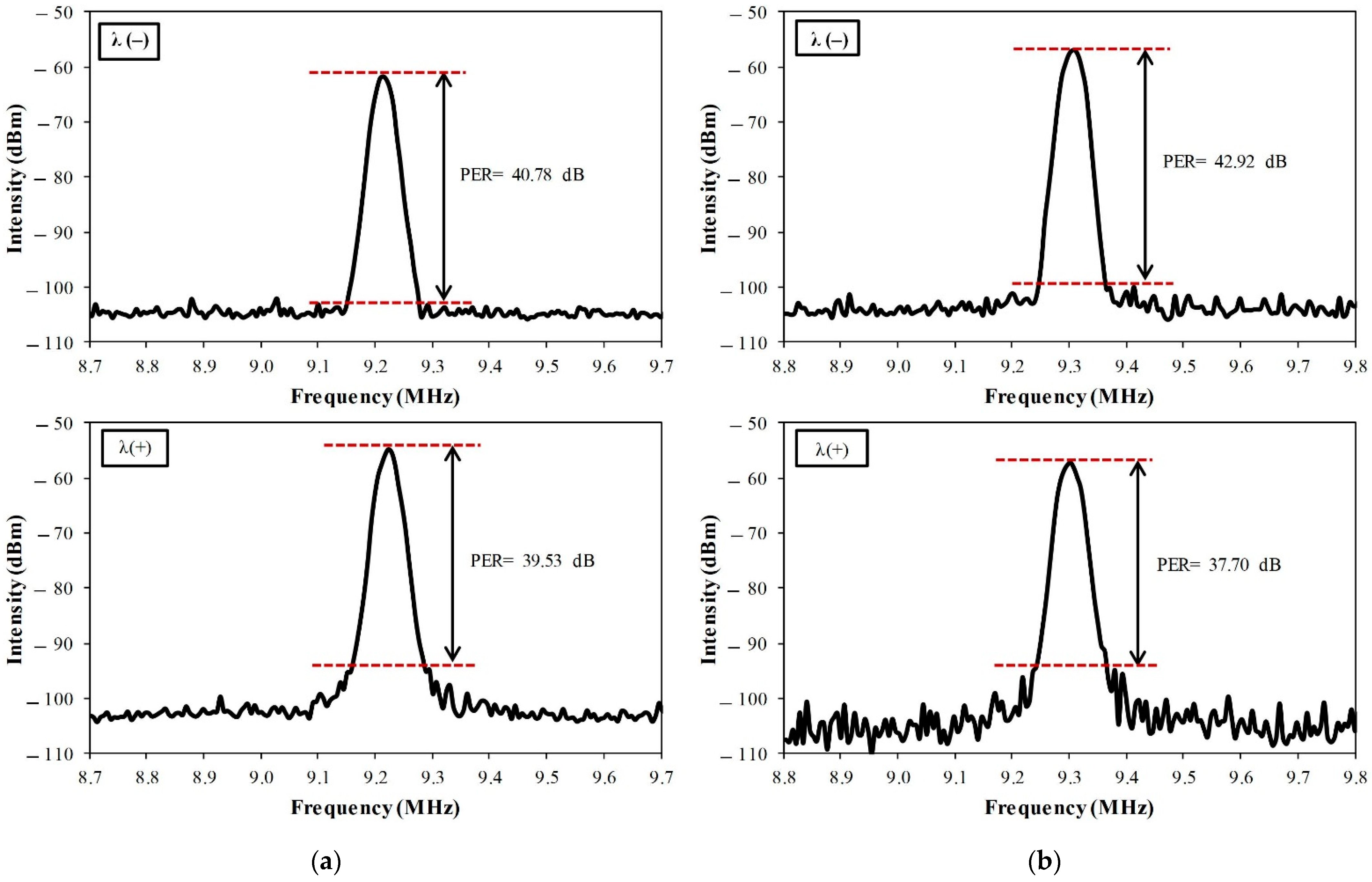

| Laser Cavity Configuration | Unidirectional DWML-EDFL | Bidirectional DWML-EDFL | ||
|---|---|---|---|---|
| Optical loops | ||||
| Maximum output power (mW) | 1.13 | 1.4 | 1.29 | 1.46 |
| Slope efficiencies (%) | 1.35 | 1.71 | 1.45 | 1.7 |
| Mode-locking threshold (mW) | 41 | 41 | 38 | 38 |
| Maximum pulse energy (pJ) | 122 | 152 | 139 | 155 |
| 3 dB bandwidth (nm) | 3.0 | 2.4 | 3.0 | 3.2 |
| Pulse width (fs) | 900 | 1020 | 890 | 980 |
| Repetition rate (MHz) | 9.26 | 9.22 | 9.29 | 9.35 |
| PER (dB) | 40.78 | 39.53 | 42.92 | 37.70 |
Publisher’s Note: MDPI stays neutral with regard to jurisdictional claims in published maps and institutional affiliations. |
© 2022 by the authors. Licensee MDPI, Basel, Switzerland. This article is an open access article distributed under the terms and conditions of the Creative Commons Attribution (CC BY) license (https://creativecommons.org/licenses/by/4.0/).
Share and Cite
Abas, A.F.; Lau, K.Y.; Muhammad, F.D.; Abdulkawi, W.M.; Al-Moliki, Y.M.; Alresheedi, M.T.; Mahdi, M.A. Dual-Wavelength Mode-Locked Oscillation with Graphene Nanoplatelet Saturable Absorber in Erbium-Doped Fiber Laser. Electronics 2022, 11, 2880. https://doi.org/10.3390/electronics11182880
Abas AF, Lau KY, Muhammad FD, Abdulkawi WM, Al-Moliki YM, Alresheedi MT, Mahdi MA. Dual-Wavelength Mode-Locked Oscillation with Graphene Nanoplatelet Saturable Absorber in Erbium-Doped Fiber Laser. Electronics. 2022; 11(18):2880. https://doi.org/10.3390/electronics11182880
Chicago/Turabian StyleAbas, Ahmad Fauzi, Kuen Y. Lau, Farah D. Muhammad, Wazie M. Abdulkawi, Yahya M. Al-Moliki, Mohammed T. Alresheedi, and Mohd Adzir Mahdi. 2022. "Dual-Wavelength Mode-Locked Oscillation with Graphene Nanoplatelet Saturable Absorber in Erbium-Doped Fiber Laser" Electronics 11, no. 18: 2880. https://doi.org/10.3390/electronics11182880
APA StyleAbas, A. F., Lau, K. Y., Muhammad, F. D., Abdulkawi, W. M., Al-Moliki, Y. M., Alresheedi, M. T., & Mahdi, M. A. (2022). Dual-Wavelength Mode-Locked Oscillation with Graphene Nanoplatelet Saturable Absorber in Erbium-Doped Fiber Laser. Electronics, 11(18), 2880. https://doi.org/10.3390/electronics11182880








